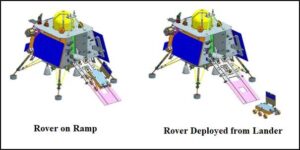Chandrayaan-3, the third lunar exploration mission by the Indian Space Research Organisation (ISRO), represents India’s ambition to expand its presence in space exploration and further our understanding of the Moon. Building upon the lessons learned from Chandrayaan-2, this mission aims to achieve a soft landing on the lunar surface and deploy a rover to explore its mysteries. With scientific and technological significance, Chandrayaan-3 is poised to contribute valuable insights into lunar geology, mineralogy, and the presence of water ice. This article delves into the mission’s objectives, key components, anticipated timeline, and potential impact.

-
Objectives of Chandrayaan-3
Chandrayaan-3 aims to fulfill several crucial objectives in lunar exploration. Firstly, it seeks to continue the scientific investigations initiated by its predecessor, Chandrayaan-2. The mission aims to study the Moon’s surface in greater detail, analyze its mineral composition, and further our understanding of its evolution.
One of the primary objectives is to attempt a soft landing on the lunar surface, a feat that Chandrayaan-2’s lander, Vikram, was unable to accomplish. The successful landing would open doors for enhanced lunar surface exploration, enabling in-situ experiments and data collection from unexplored regions.
Chandrayaan-3 also seeks to investigate the presence of water ice on the Moon, particularly in the south pole region. Water resources on the Moon can be of great importance for future lunar missions, as they can potentially support human habitation and act as a source of fuel for deep space exploration.
-
Mission Components
Chandrayaan-3, like its predecessor, comprises three main components: the orbiter, the lander, and the rover.
The orbiter serves as the mission’s backbone, carrying scientific instruments to perform remote sensing observations and collect data about the Moon. It will continue to study the lunar surface from its vantage point, providing high-resolution imagery and mapping of the Moon’s topography.
The lander, a critical component, is designed to achieve a soft landing on the lunar surface. It will carry scientific payloads to conduct experiments on the Moon’s surface, including investigations into its composition, mineralogy, and thermal properties. The lander will act as a communication link between the rover and the orbiter, relaying data back to Earth.
The rover, equipped with cutting-edge scientific instruments, will be deployed onto the lunar surface from the lander. It will traverse the Moon’s terrain, conducting experiments, collecting samples, and analyzing the lunar soil. The rover’s mobility will allow it to explore a wider area, providing valuable data about the Moon’s geology and potential resources.
-
Anticipated Timeline
While the exact launch date of Chandrayaan-3 has not been officially announced as of my knowledge cutoff in September 2021, it was anticipated to take place in late 2022 or early 2023. ISRO has been meticulously working on the mission, addressing the challenges faced during Chandrayaan-2 to ensure a successful outcome this time.
The timeline for Chandrayaan-3 involves multiple stages, including pre-launch preparations, launch, lunar journey, lunar orbit insertion, descent, and landing. Each stage demands precise planning and flawless execution to achieve the mission’s objectives.
-
Potential Impact
The successful execution of Chandrayaan-3 will have significant scientific and technological implications for India and the global space community. From a scientific perspective, the mission will provide crucialdata and insights into the Moon’s geology, mineralogy, and the presence of water ice. This information will contribute to our understanding of the Moon’s evolution and its potential as a resource-rich celestial body.
The mission’s findings on water ice, especially in the lunar south pole region, could have far-reaching implications. Water is essential for sustaining future human exploration and colonization efforts on the Moon. It can potentially be extracted and utilized for drinking water, oxygen production, and as a propellant for spacecraft, reducing the cost and complexity of deep space missions.
Chandrayaan-3 will also bolster India’s expertise in space exploration and further enhance its reputation as a space-faring nation. By successfully achieving a soft landing on the Moon and deploying a rover, ISRO will demonstrate its capabilities in lunar surface operations, joining a select group of countries that have accomplished such missions.
Moreover, the technological advancements and engineering challenges overcome during Chandrayaan-3 will serve as valuable lessons for future missions. The experience gained in designing and operating the lander, rover, and orbiter will directly benefit upcoming lunar and planetary exploration endeavors. These lessons can be applied to develop more advanced and sophisticated spacecraft for both robotic and human missions.
Furthermore, the Chandrayaan-3 mission holds the potential to inspire future generations and foster scientific curiosity. As India continues to make strides in space exploration, the mission will encourage young minds to pursue careers in science, technology, engineering, and mathematics (STEM) fields. It will serve as a catalyst for innovation, research, and development in the country’s space sector, nurturing a strong foundation for future space exploration endeavors.
Chandrayaan-3 represents India’s determination to push the boundaries of lunar exploration and expand its presence in the realm of space exploration. With its ambitious objectives, including a soft landing and rover deployment on the lunar surface, the mission aims to gather crucial scientific data, study the Moon’s composition, and investigate the presence of water ice.
The mission’s success would have far-reaching implications, from advancing our understanding of the Moon’s geology and evolution to potentially unlocking valuable resources for future human exploration. Chandrayaan-3 will also reinforce India’s position as a significant player in the global space community and pave the way for future lunar and planetary missions.
As the mission progresses, it is essential to closely follow updates and official announcements from ISRO for the most accurate and up-to-date information. Chandrayaan-3 represents another remarkable step in humanity’s quest to explore and comprehend the vastness of our celestial neighbor, the Moon.


 Taxi Booking Chet
Taxi Booking Chet